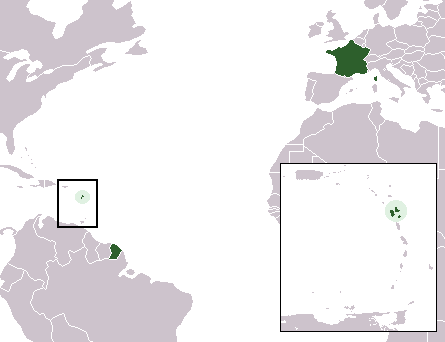 Guadeloupe (French pronunciation: [ɡwadəlup]; English: /ɡwɑːdəˈluːp/; Antillean Creole: Gwadloup) is an archipelagolocated in the Leeward Islands, in the Lesser Antilles, with a land area of 1,628 square kilometres (629 sq. mi) and a population of 400,000. It is the first overseas region of France, consisting of a single overseas department. As with the other overseas departments, Guadeloupe is also one of the twenty-six regions of France (being an overseas region) and an integral part of the Republic since 2007.
Guadeloupe (French pronunciation: [ɡwadəlup]; English: /ɡwɑːdəˈluːp/; Antillean Creole: Gwadloup) is an archipelagolocated in the Leeward Islands, in the Lesser Antilles, with a land area of 1,628 square kilometres (629 sq. mi) and a population of 400,000. It is the first overseas region of France, consisting of a single overseas department. As with the other overseas departments, Guadeloupe is also one of the twenty-six regions of France (being an overseas region) and an integral part of the Republic since 2007.
As part of France, Guadeloupe is part of the European Union; hence, as for most EU countries, its currency is the euro. However, Guadeloupe is not part of the Schengen Area. The prefecture and the capital of Guadeloupe is Basse-Terre. Christopher Columbus named the island Santa María de Guadalupe in 1493 after the Virgin Mary, venerated in the Spanish town of Guadalupe, in Extremadura.
Sighted by Christopher Columbus in 1493, Guadeloupe was only feebly colonized by the Spanish and was finally abandoned in 1604. In 1635 settlement was begun by the French, who eliminated the native Caribs and imported slaves from Africa for plantation work. By the end of the 17th century, Guadeloupe was a leading world sugar producer and one of France’s most valuable colonies. The islands were hotly contested with the English until they were confirmed as French possessions in 1815.
During World War II, Guadeloupe at first adhered to the Vichy regime in France, but an accord with the United States in 1942 led to its support of the Free French. In 1946 the colony of Guadeloupe became an overseas department of France, and in 1974 it became an administrative center. Its deputies sit in the French National Assembly in Paris.
Guadeloupe’s culture is probably best known for the islanders’ literary achievements, particularly the poetry of Saint-John Perse, the pseudonym used by Alexis Léger. Perse won the 1960 Nobel Prize in Literature “for the soaring flight and the evocative images of his poetry, which, in a visionary fashion, reflects the conditions of our time.”
Guadeloupe has always had a rich literary production prolonged today by many living writers, poets, novelists, essayists and journalists, among them Mesdames Maryse Condé and Simone Schwartz-Bart, M. Ernest Pépin.
Also culturally important are the arts, particularly painting and sculpture. Famous painters and/or sculptors include Michel Rovelas, Claudie Cancelier, Jean-Claude Echard, Christian Bracy, Roger Arekian, les Frères Baptiste, Michelle Chomereau-Lamothe, Léogane, Pédurand, Nicole Réache, Richard-Viktor Sainsily.
Tourism is the major industry, and the majority of people are employed in the service sector. Agriculture and sugar and rum production are also important. Basse-Terre, volcanic in origin and extremely rugged, is settled along the coasts and produces bananas, other tropical fruits and vegetables, coffee, cacao, and vanilla beans. Grande-Terre has low limestone cliffs and little rainfall; sugar and rum are its chief products. There also is subsistence farming, livestock raising, and fishing. Additionally, France provides many subsidies and necessities to Guadeloupe.
Notes from Wikipedia and Answers.com









